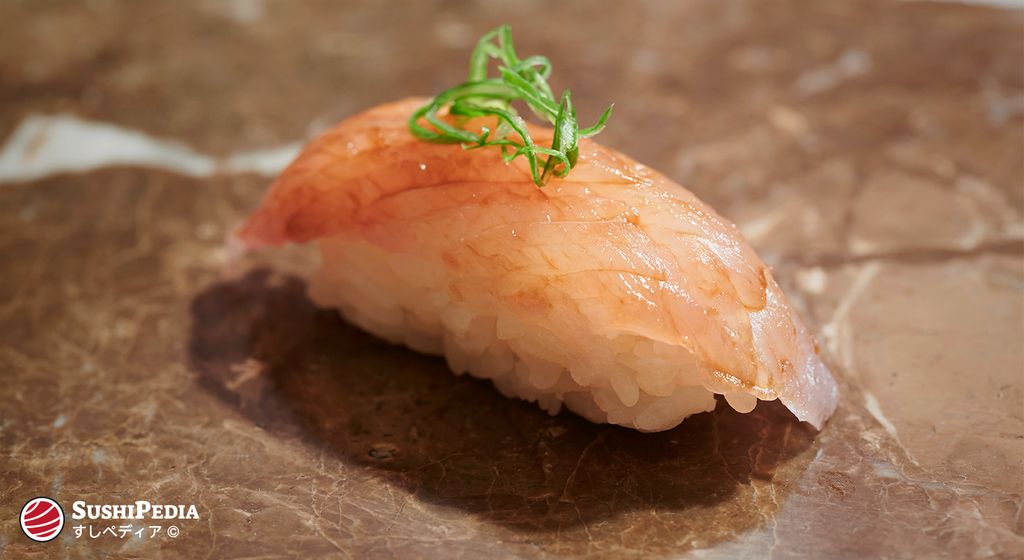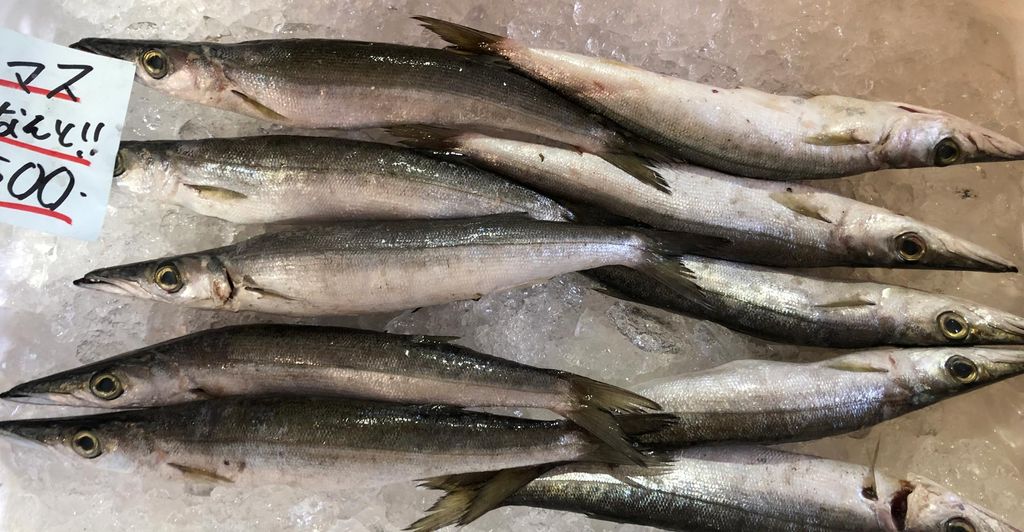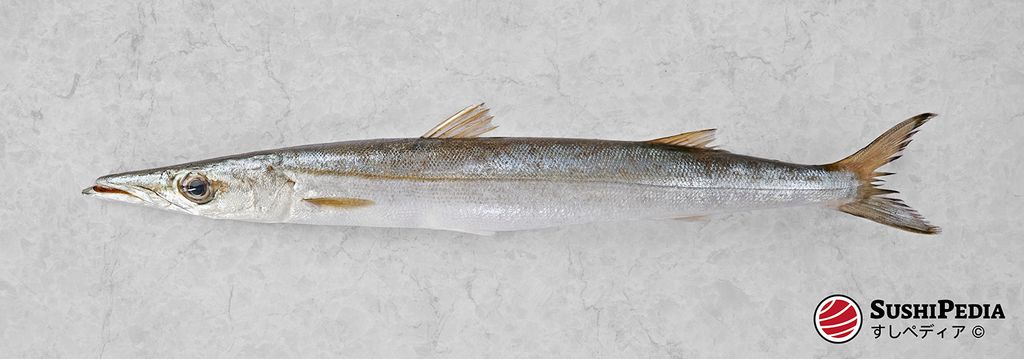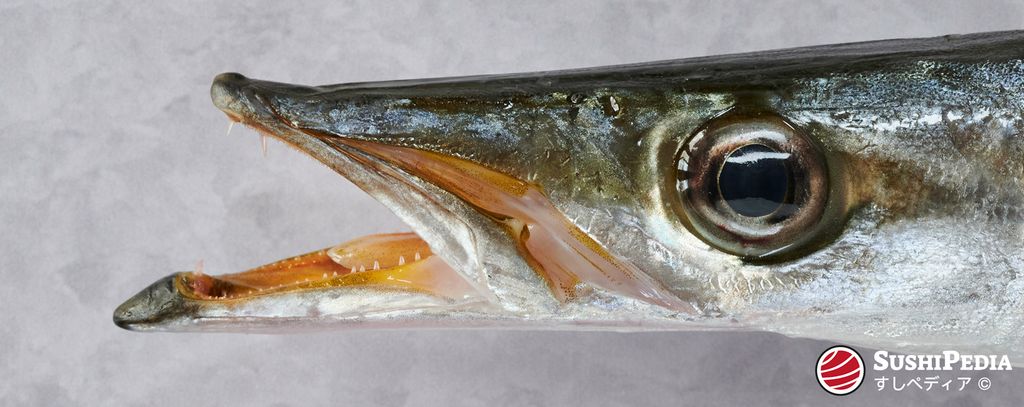Kamasu Sushi
A Comprehensive Overview of Barracuda in Japanese Sushi Cuisine
カマスすし 、 魳(梭子魚・魣)寿司 
What is Kamasu?
Kamasu 魳 is the Japanese generic term for a group of fish from the Sphyraenidae family, commonly known as barracudas. These extraordinary sea creatures have a slender, streamlined body and are characterized by their long jaws, which are covered with sharp, fang-like teeth. The family Sphyraenidae comprises around 28 species, which vary considerably in size. Kamasu is popular for its lean, firm texture and taste and is ideal for preparing sushi.
The scientific name of the barracuda, Sphyraena, comes from the Greek and means “arrow”. This name refers to the slender, arrow-shaped bodies of the fish and their ability to shoot through the water like an arrow.
Kamasu as an Ingredient for Sushi or Sashimi
Kamasu is highly prized in Japanese cuisine. Its meat is lean, with a subtly sweet taste. The flesh is translucent, firm, and white. When exposed to heat, the meat contracts. The meat of kamasu is characterized by a high water content, while the skin has a distinctive aroma that is not to everyone's taste. The suitability of the skin for raw consumption or preparation for sushi is therefore assessed differently. However, if you prefer to eat sushi with the skin, it is advisable to lightly grill the skin. The skin is thin and aromatic, and heating it releases additional flavors. If the meat is served without the skin, it tastes milder and more mineral. The flesh is white, relatively firm, with a characteristic, strong aroma. Younger fish taste lighter and less intense. The intensity of the flavor varies depending on the species.
When preparing kamasu nigiri sushi, the meat is often pre-treated with salt or a mixture of salt and vinegar to firm it up before shaping and to reduce the inherent odor.

SushiPedia. Barracuda Sushi. All rights reserved ©
In addition to preparation as sushi or sashimi, kamasu is versatile in the kitchen. Thanks to its high water content, it is easy to dry and is therefore a good candidate for dried fish preparations. Its fatty skin gives it an excellent flavor, especially when used in grilled dishes. From a nutritional point of view, kamasu is a white-fleshed fish that is rich in high-quality protein. Compared to oily fish, it has fewer calories and contains valuable nutrients such as vitamin D and vitamin B12.
Types of Kamasu for Sushi
In Japan, two types of kamasu, namely aka-kamasu and yamato-kamasu, are typically used as food. However, aka-kamasu is less valued in comparison, as it loses its freshness more quickly, which is reflected in a lower price in the trade.
Red Barracuda (Aka Kamasu)

Totti. Sphyraena pinguis on the market. commons.wikimedia.org. Some rights reserved: CC BY-SA 4.0. Changes applied: crop
Aka Kamsu アカカマス is considered the most frequently encountered barracuda on the coasts of Japan. They are often found near the coast and in harbors. It is mainly caught in coastal waters and, although it is one of the two main species, it is known for its excellent taste and the higher price associated with it. The red barracuda is marketed both in its original state and in the form of preserved products such as dried fish. In the past, this fish was mainly grilled in salt when it was fresh. The main season is from fall to early summer, with the fat content being particularly high from late spring to early summer. The meat is characterized by its high moisture content.
Japanese Barracuda (Yamato Kamasu)
Yamato Kamasu ヤマトカマス is found in the shallow coastal waters of Japan, except for the Ryukyu Islands, and is in peak season twice a year, in spring and fall. Large quantities are sold on the market, especially from the beginning of August into the fall. Although the fish is sometimes sold fresh, it is often processed into dried products. If the freshness is very good, the fish can be prepared raw. Due to the rapid loss of freshness, it is difficult to enjoy this fish in high quality outside the catching area. In season, the flesh has a rich sweetness and umami flavor, especially when the fat melts in the mouth. The flesh is translucent white, but the bloodline is pronounced and quickly darkens in color. The meat remains relatively soft even when cooked.
Kamasu Trivia
Barracudas in Pop Culture
Barracudas often have a bad reputation in pop culture. They are typically portrayed as dangerous and aggressive predatory fish, for example in films and literature. However, attacks on humans are extremely rare and usually only occur when the fish feels threatened.
Food Poisoning by Barracuda: A Case Report From Tokyo in 1949
In 1949, a researcher took the opportunity to look into an incident of food poisoning caused by the consumption of barracuda meat in Tokyo. On May 20 of that year, about thirty people from five families fell ill after eating the fish. The fish meat was brought to Tokyo by a tuna fishing boat, presumably from the tropical Pacific. The barracuda involved was about one meter long and was identified as Sphyraena barracuda (greater barracuda, then S. picuda). One hour after eating the fish, all those affected initially experienced numbness in the lips and mouth, followed by tingling in the mouth, unsteady gait and a feeling of drunkenness. In more severe cases, there was increased salivation, but no vomiting, nausea or diarrhea. Although the symptoms were severe, all patients appeared to have recovered within two days without permanent damage. As the fish was preserved in good condition and none of the patients had noticed any foul odor or abnormal taste, it seemed unlikely that the poisoning was due to bacterial spoilage of the fish. Thanks to the assistance of a technical officer, 55 grams of the fillet cooked with soy sauce, which had been kept by a family, was recovered for examination [1].

Inger Schulstad. Municipal Archives of Trondheim. Ginza shoppingdistrikt i Tokyo (1952). commons.wikimedia.org. Some rights reserved: CC BY 2.0 DEED. Changes applied: crop, noise, white balance
The symptoms experienced in the 1949 paragraph described after eating barracuda meat, such as numbness in the lips and mouth, tingling, unsteadiness of gait and a feeling of drunkenness, are similar to those of ciguatera fish poisoning. Ciguatera is known to cause neurological symptoms such as numbness and tingling. In addition, barracuda are known to be one of the fish species that can accumulate ciguatoxins, especially when caught in tropical waters. It is also important to note that there was no evidence of bacterial spoilage, suggesting that the poisoning was likely due to naturally occurring toxins in the fish, and this fits with the nature of ciguatoxins. However, at that time (1949) there was too little knowledge and no technology to definitively determine which toxins were involved. In addition, other marine biotoxins can also cause similar symptoms.
According to a notice issued by the Japanese Ministry of Health and Welfare on June 22, 1953 (now the Ministry of Health, Labor and Welfare), the sale of the great barracuda (S. barracuda) is prohibited. According to the ministry, the fish is classified as a danger to human health.[2]
Characteristics and Ecology of Kamasu

SushiPedia. European Barracuda (Juvenile Fish). All rights reserved ©
Barracudas possess a long, slender and torpedo-shaped body that is optimized for high speeds in the water. Their shimmering scales can display a range of colors, including gray, blue and green, helping to camouflage them in the depths of the ocean. One of their most distinctive features is their impressive dentition with pointed teeth, which allows them to grab their prey effectively. Barracudas attack their prey from ambush. They use their high speed and their ability to remain motionless in the water to suddenly strike and seize their prey with their razor-sharp teeth.

SushiPedia. Close-up of a European Barracuda’s Mouth. All rights reserved ©
The great barracuda (S. barracuda), for example, can reach a length of up to 1.8 meters and weigh over 40 kilograms. This makes it one of the largest members of the Sphyraenidae family, and it is known for its impressive speed. Another example is the Pacific barracuda (S. argentea), which, despite its smaller size compared to the great barracuda, is remarkably adaptable to different marine biotopes. It mainly inhabits the open sea, but also nearshore areas, and can reach a length of up to 1 meter.
Ecology and Habitat
Barracudas are mainly found in tropical and subtropical waters around the world. They generally prefer warm, clear waters and are often found near coral reefs and seagrass beds, where they have access to a variety of prey.
As predatory fish, barracudas are quite high up the food chain, feeding mainly on smaller fish such as herring and mackerel species. They are known for their ability to hunt at high speed and often use the tactic of surprise attack to overpower their prey.
Ecological Importance
Barracudas play an important role in the marine ecosystem. As predators, they help to maintain the balance of fish populations by controlling the numbers of smaller fish. In addition, they are a sought-after sighting for many divers and snorkelers and thus indirectly contribute to ecotourism, which is a significant source of income for many coastal communities.
Sustainability and Conservation
It is crucial to manage barracuda populations sustainably and protect their habitat. Overfishing and the destruction of coral reefs are threats that can affect their populations. Environmental protection measures, sustainable fishing practices and public awareness of the value of these fascinating marine creatures are key elements in the conservation of barracudas and the marine ecosystems in which they live.
Ciguatoxin
Barracudas are predatory fish commonly found in reefs and are particularly susceptible to ciguatoxin accumulation. Larger and older barracudas are probably more likely to have accumulated significant amounts of the toxin over time, as they consume smaller fish more frequently. Ciguatoxin is a neurotoxin produced by microscopic marine algae called dinoflagellates. These algae are mainly found in tropical and subtropical waters. Fish that feed on these algae accumulate the toxin, and when larger predatory fish such as barracudas eat smaller fish, the toxin concentrates in their tissues. Remarkably, ciguatoxin is heat-stable, which means that it does not lose potency when cooked. Ciguatera poisoning manifests itself through a range of symptoms from gastrointestinal discomfort to neurological and cardiovascular problems. The most common symptoms include nausea, vomiting, diarrhea, muscle pain and tingling in the extremities. In severe cases, breathing difficulties, heart issues or even chronic symptoms that last for weeks or months can occur. If you plan to eat barracuda, be sure to check local conditions, as some regions are more prone to the presence of ciguatoxin. Follow the recommendations of local health authorities for eating fish or seafood that may cause ciguatera poisoning.
Season Calendar for Kamasu
The calendar shown does not provide information on fishing times, but marks the periods in which kamasu is considered particularly tasty.
Warnings related to Kamasu
Species of Kamasu
The following species are regarded as authentic kamasu. Either historically, according to the area of distribution or according to the common practice in today's gastronomy:
In the following, those species are listed that can be considered as substitutes for authentic species with regard to kamasu. This can be based either on their genetic relationship or on their similarity in taste and appearance. The selection is subjective and is not strictly based on Japanese conventions, but also takes into account the practices in the respective areas where the Japanese dishes are prepared. This flexible approach allows for adaptation to local availability and preferences while preserving the core flavor and texture traditionally associated with kamasu.
Sources and Further Reading
- [1]Yoshiro Hashimoto. A Note on the Poison of a Barracuda, Sphyraena picuda Bloch & Schneider. Nippon Suisan Gakkaishi 21 (11) 1153-1157. 1956. DOI: https://doi.org/10.2331/suisan.21.1153.
- [2]『自然毒のリスクプロファイル:魚類:シガテラ毒 (Risk profile of natural toxins: fish: ciguatera venom)』. 厚生労働省, Ministry of Health, Labour and Welfare、 2023. Source retrieved 6/22/2023
- [3]Fish and Fishery Products Hazards and Controls Guidance, June 2022 Edition. U.S. Department of Health and Human Services, Food and Drug Administration Center for Food Safety and Applied Nutrition. 2022
- [4]J. Matta, M. Milad, R. Manger, T. Tosteson. Heavy metals, lipid peroxidation, and ciguatera toxicity in the liver of the caribbean barracuda (Sphyraena barracuda). Biological Trace Element Research 70 6979. 1999. DOI: https://doi.org/10.1007/BF02783850.
- 『アカカマス | 魚類 | 市場魚貝類図鑑』. ぼうずコンニャク株式会社. Source retrieved 6/20/2023
- IUCN Red List of Threatened Species. Version 2023-1
Image Credits
- SushiPedia. European Barracuda (Juvenile Fish). All rights reserved ©
- SushiPedia. Barracuda Sushi. All rights reserved ©
- Inger Schulstad. Municipal Archives of Trondheim. Ginza shoppingdistrikt i Tokyo (1952). commons.wikimedia.org. Some rights reserved: CC BY 2.0 DEED. Changes applied: crop, noise, white balance
- SushiPedia. Close-up of a European Barracuda’s Mouth. All rights reserved ©
- SushiPedia. All rights reserved ©
- Totti. Sphyraena pinguis on the market. commons.wikimedia.org. Some rights reserved: CC BY-SA 4.0. Changes applied: crop